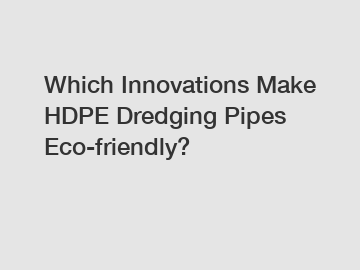Which Innovations Make HDPE Dredging Pipes Eco-friendly?
Which Innovations Make HDPE Dredging Pipes Eco-friendly?
In today's world, sustainability and environmental consciousness have become crucial considerations in nearly every industry. The dredging industry is no exception, as it seeks to minimize its impact on the environment and adopt eco-friendly practices. One significant aspect of this effort is the use of High-Density Polyethylene (HDPE) dredging pipes. These innovative pipes have several features that make them not only efficient but also environmentally friendly. Let's explore the various innovations that contribute to the eco-friendliness of HDPE dredging pipes.
1. Material Selection:

The choice of material plays a vital role in making HDPE dredging pipes eco-friendly. HDPE pipes are made from a polymer called high-density polyethylene, which is known for its recyclable and sustainable nature. Unlike traditional materials such as steel or concrete, HDPE pipes can be recycled, reducing waste and conserving resources. This material also has a significantly lower carbon footprint compared to other alternatives, contributing to greenhouse gas reduction.
2. Corrosion Resistance:
Another advantage of HDPE dredging pipes is their excellent corrosion resistance. Unlike metal pipes, HDPE pipes are not prone to rusting or deteriorating over time. This means they require less maintenance and replacement, resulting in reduced waste generation. By using HDPE pipes, dredging companies can minimize their environmental impact by ensuring that pipes remain in service for an extended period, without the need for frequent replacements or repairs.
3. Durability and Longevity:
HDPE dredging pipes are designed to withstand harsh conditions, such as abrasion, impact, and extreme weather. These pipes have a high strength-to-density ratio, making them sturdy and resilient. The durability of HDPE pipes ensures a longer lifespan, reducing the need for frequent replacements. This longevity not only reduces waste but also lowers the carbon emissions associated with the production and transportation of new pipes.
4. Flexibility and Lightweight:
HDPE dredging pipes are lightweight and flexible, making them easy to transport and install. Their lightweight nature reduces the fuel consumption required during transportation, resulting in lower greenhouse gas emissions. The flexibility of HDPE pipes also allows for easier installation, as they can be bent and maneuvered without the need for multiple joints. This reduces the potential for leakage and ensures better energy efficiency during dredging operations.
5. Leak-free Joints:
One of the major innovations in HDPE dredging pipes is the development of leak-free joints. Traditional pipes often require additional sealing materials, like adhesives or rubber gaskets, to ensure watertight connections. However, HDPE pipes employ fusion welding techniques to create seamless and leak-free joints. This eliminates the need for external sealing materials, reducing the potential for environmental contamination through leakage. Additionally, leak-free joints help optimize operational efficiency by minimizing energy loss during dredging activities.
6. Resistance to Chemicals and UV Exposure:
HDPE dredging pipes exhibit excellent resistance to various chemicals, including acids, alkalis, and other corrosive substances. This attribute allows them to withstand the chemical environment typically encountered during dredging operations without degradation. Furthermore, HDPE pipes are also resistant to UV radiation, ensuring their longevity even in exposed outdoor environments. By being impervious to chemical and UV damage, HDPE dredging pipes minimize the risk of leaks and subsequent environmental contamination.
In conclusion, HDPE dredging pipes offer several innovations that contribute to their eco-friendliness. The material's recyclability and sustainable nature, coupled with its corrosion resistance and durability, make HDPE pipes an environmentally conscious choice. The lightweight and flexible design of these pipes, along with their leak-free joints, enhance operational efficiency while minimizing waste and energy consumption. Additionally, the resistance to chemicals and UV exposure ensures their longevity and prevents environmental contamination. As the dredging industry continues to prioritize sustainability, HDPE dredging pipes prove to be a valuable solution, helping to reduce the industry's environmental footprint. By embracing these innovations, companies can strive towards a greener and more sustainable future.
If you are looking for more details, kindly visit pvc drainage pipe price, hdpe steel bellows, HDPE Double Wall Corrugated Pipe for Rainwater system.


